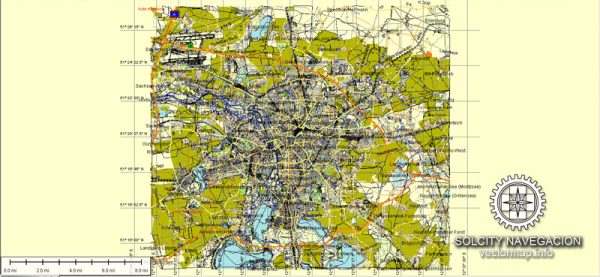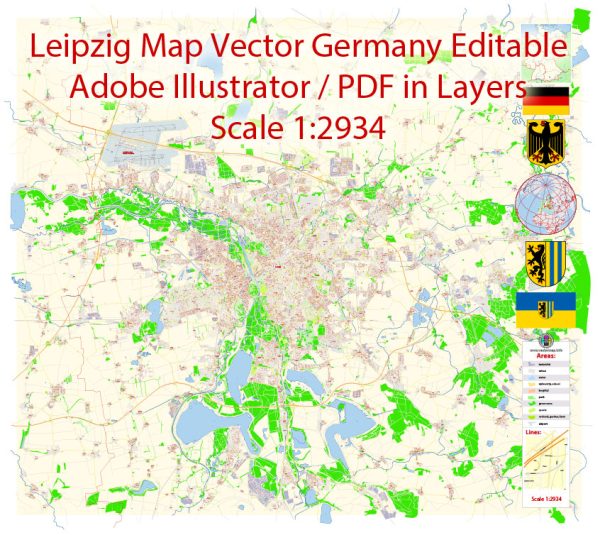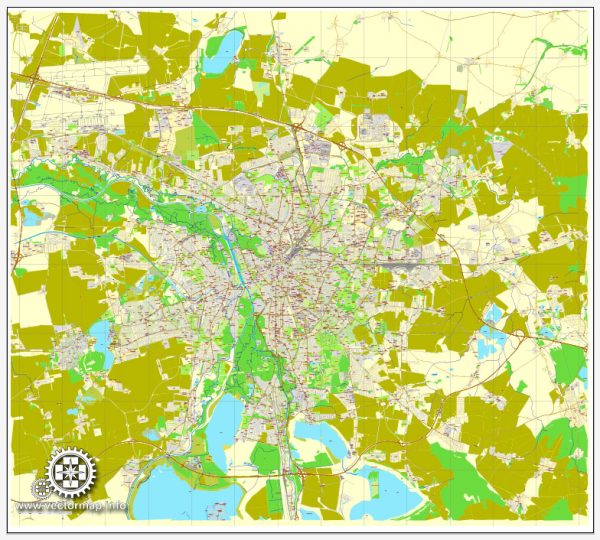Leipzig is a historic and vibrant city located in the federal state of Saxony, Germany. Known for its rich cultural heritage, musical history, and academic prominence, Leipzig has played a significant role in shaping Germany’s cultural and intellectual landscape. Vectormap.Net provide you with the most accurate and up-to-date vector maps in Adobe Illustrator, PDF and other formats, designed for editing and printing. Please read the vector map descriptions carefully. Here is a detailed description of the city:
History:
- Trade and Commerce: Leipzig has a long history as a major trade and commerce hub, dating back to medieval times. The city’s location at the intersection of important trade routes contributed to its economic prosperity.
- Battle of Leipzig: The city gained historical significance during the Napoleonic Wars with the Battle of Leipzig in 1813, also known as the Battle of Nations. It marked a turning point in the war against Napoleon and is considered one of the largest battles in European history.
Architecture and Landmarks:
- St. Thomas Church (Thomaskirche): A significant Lutheran church known for its association with Johann Sebastian Bach. Bach served as the choir director here, and his remains are interred in the church.
- St. Nicholas Church (Nikolaikirche): Another historic church, St. Nicholas played a pivotal role in the peaceful protests against the East German government that led to the fall of the Berlin Wall in 1989.
- Leipzig Opera House (Oper Leipzig): One of the most prominent opera houses in Germany, renowned for its performances and architectural elegance.
- Auerbachs Keller: A historic restaurant and wine bar mentioned in Johann Wolfgang von Goethe’s “Faust.” It has a rich history and is a popular spot for both locals and tourists.
Culture and Education:
- Leipzig Book Fair: An annual event attracting authors, publishers, and book enthusiasts from around the world. It is one of the oldest and most significant book fairs globally.
- Leipzig Gewandhaus Orchestra: Founded in 1743, the Gewandhaus Orchestra is one of the world’s oldest symphony orchestras. The Gewandhaus concert hall is a renowned venue for classical music performances.
- Leipzig University: Founded in 1409, Leipzig University is one of the oldest universities in Germany. It has a strong academic reputation and has produced notable scholars over the centuries.
Parks and Recreation:
- Clara-Zetkin-Park: A large park along the White Elster River, offering green spaces, walking paths, and recreational areas. It is a popular spot for outdoor activities and relaxation.
- Leipzig Zoo: One of the oldest zoos in the world, Leipzig Zoo is home to a diverse range of animals and is involved in various conservation initiatives.
Neighborhoods:
- Zentrum (City Center): The central district with a mix of historical and modern architecture, shopping areas, and cultural attractions.
- Südvorstadt: A trendy and vibrant neighborhood known for its diverse community, cafes, and artistic atmosphere.
- Plagwitz: An industrial-turned-artsy district with galleries, studios, and a hipster vibe.
Transportation:
- Leipzig/Halle Airport: An international airport providing air connectivity to the city.
- Leipzig Hauptbahnhof: The main railway station, one of the largest railway stations in Europe, connecting Leipzig to major cities in Germany and beyond.
Leipzig’s combination of historical significance, cultural richness, and academic excellence makes it a fascinating destination for both residents and visitors. The city’s commitment to the arts, literature, and music has earned it a well-deserved place in Germany’s cultural heritage.




 Author: Kirill Shrayber, Ph.D.
Author: Kirill Shrayber, Ph.D.